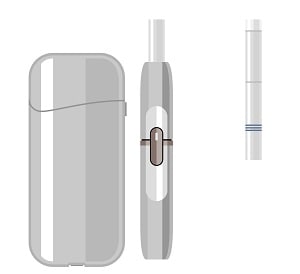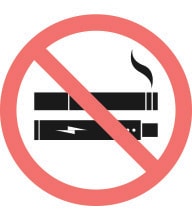At a glance
- Heated tobacco products heat processed tobacco leaf, allowing users to inhale nicotine into their lungs.
- The use of any type of tobacco product—including heated tobacco products—is harmful.

What's the bottom line?
Heated tobacco products heat processed tobacco leaf, allowing users to inhale nicotine into their lungs. Some brands of heated tobacco products permitted for sale in the United States include IQOS and Eclipse.
More research is needed to understand the short- and long- term health effects of heated tobacco products.
The use of any type of tobacco product—including heated tobacco products—is harmful. They are especially harmful for youth, young adults, and pregnant women, as well as adults who do not currently use tobacco products.
Heated tobacco products have not been scientifically shown to help people who smoke cigarettes to quit.
If you've never used tobacco products, including heated tobacco products, don't start.
What are heated tobacco products?
Sometimes marketed as "heat-not-burn" products, heated tobacco products come in many forms.
Some heated tobacco products use electronic heating elements.
- Some heat specially designed sticks, plugs, or capsules containing tobacco. This is how the electronically heated tobacco product authorized for sale in the United States works.
- Some work by heating liquids that create an emission that then passes through a tobacco plug to absorb flavor and nicotine from the tobacco.
- Some have a sealed part of the device that heats loose tobacco, either alone or together with flowers from the marijuana (cannabis) plant.
- Some are used with flavorings.
- Some allow users to control factors such as the temperature.

Some heated tobacco products have a similar size and shape as regular cigarettes and have a carbon tip wrapped in glass fibers that the user heats with a lighter or match. Federal law allows this type of product to be sold in the United States.
Are heated tobacco products the same as electronic cigarettes?
No. Heated tobacco products heat actual tobacco leaf. By contrast, e-cigarettes heat liquids that typically contain nicotine derived from tobacco, as well as flavorings and other ingredients. Learn more about e-cigarettes.
What are the health effects of using heated tobacco products?
Heated tobacco products are still new in the United States. Scientists are still learning about their short- and long-term health effects.
The use of any tobacco product—including heated tobacco products—is harmful, especially for youth, young adults, and pregnant women. They are also harmful for adults who do not currently use tobacco products.
Regardless of whether they are heated by flame or electronically, heated tobacco products contain nicotine.
Nicotine is highly addictive.1
Nicotine exposure can also harm the developing adolescent brain. The brain keeps developing until about age 25.1
- Using nicotine in adolescence can harm the parts of the brain that control attention, learning, mood, and impulse control.
- Using nicotine in adolescence may also increase the risk for future addiction to other drugs.
Nicotine is toxic to developing fetuses.1
Is it harmful to breathe the secondhand emissions from heated tobacco products?
- Heated tobacco products produce emissions that are not as safe as clean air.
- Studies of secondhand emissions from heated tobacco products suggest that the products expose both users and bystanders to some of the same chemicals found in cigarette smoke, although at lower levels than cigarette smoke.2
- Additional research is needed to understand the health effects of heated tobacco products and their emissions.
Are heated tobacco products less harmful than regular cigarettes?
The emissions created from heated tobacco products generally contain lower levels of harmful ingredients than the smoke from regular cigarettes. However, that does not mean heated tobacco products are safe.
Research suggests that heated tobacco products and their emissions contain many of the same harmful ingredients as regular cigarettes, as well as other harmful ingredients not present in regular cigarettes.
Additional research is needed to determine whether adults who smoke cigarettes who completely switch to heated tobacco products might reduce their risks of tobacco-related disease. Studies from other countries suggest that most adults who use heated tobacco products have not quit using cigarettes. Surveys of young adults in the U.S. suggest that young adults also use heated tobacco products in combination with other tobacco products. Use of multiple tobacco products is associated with increased risk for nicotine dependence and adverse health effects.
As of February 2022, the U.S. Food and Drug Administration (FDA) has authorized only one heated tobacco product system (IQOS and three of its tobacco-containing Heatstick products) to be marketed as modified risk tobacco products. These were the first tobacco products to receive "exposure modification" orders. These specific products may be marketed with claims that a person who uses regular cigarettes and fully switches to IQOS can reduce their exposure to harmful chemicals.
Similar claims may not be made about other heated tobacco products or about secondhand exposure to emissions from these products. In addition, the manufacturer of IQOS may not claim that using IQOS reduces the risk of disease, that the products are endorsed or approved by the FDA, or that the FDA deems the products to be safe for use by consumers.34
Not an FDA-approved method
Who is using heated tobacco products?
- These products are new in the United States. As of February 2022, the U.S. Food and Drug Administration (FDA) has authorized only IQOS and Eclipse heated tobacco products for sale in this country. Sales of other heated tobacco products are growing worldwide.
- CDC began tracking use of heated tobacco products among U.S. adults in 2017. At that time, 0.7% of adults, including 2.7% of people who currently smoked regular cigarettes, reported they had ever used a heated tobacco product.5
- Reported use of heated tobacco products went up in 2018, when 2.4% of adults, including 6.7% of people who currently smoked regular cigarettes, reported to CDC that they had ever used a heated tobacco product.6
- A different survey from 2019 found that the proportion of adults who use e-cigarettes and reported they have ever used a heated tobacco product was higher than the proportion of adults who smoke cigarettes and reported that they have ever used a heated tobacco product.
- In 2023, 1.0% of U.S. middle and high school students, combined, reported having used heated tobacco products in the past 30 days.7
What can people do to address use of heated tobacco products?
States, communities, tribes, and territories can implement evidence-based, population-level strategies that address use of all forms of tobacco products, including heated tobacco products, such as:
- Incorporating all tobacco products, including heated tobacco products, into smokefree and tobacco-free policies.
- Licensing retailers who sell tobacco products, restricting young people's access to tobacco products in retail settings, and enforcing laws that penalize retailers who sell tobacco products to underage people.
- Implementing policies to raise the price of tobacco products.
- Reducing access to flavored tobacco products.
- Curbing advertising and marketing for tobacco products that is appealing to young people.
- Developing educational initiatives that warn about the risks of tobacco product use, especially among young people.89
Parents and teachers can:
- Learn about the different types of tobacco products and the risks of using tobacco products, including heated tobacco products.
- Set a good example by being tobacco-free and maintaining a tobacco-free home.
- Talk to children, teens, and young adults about why all forms of tobacco products are harmful for them.
- Develop, implement, and enforce tobacco-free school policies and prevention programs that are free from tobacco industry influence, and that address all types of tobacco products, including heated tobacco products.9

Health professionals can:
- Learn about the different types of tobacco products and the risks of using tobacco products.
- Ask about use of all forms to tobacco products, including heated tobacco products, when screening patients for the use of tobacco products.
- Talk to children, teens, and young adults about why all forms of tobacco products are harmful for them.
- Encourage patients to quit using tobacco products and provide them support and evidence-based treatments to help them quit successfully.10
More information
- Guide for quitting smoking: Provides free resources, including a mobile app and quit guide.
- World Health Organization's Heated Tobacco Products (HTPs) Information Sheet: Describes what heated tobacco products are and summarizes the evidence concerning these products.
- World Health Organization's Information Sheet: Measuring Priority Emissions in Heated Tobacco Products, Importance for Regulators and Significance for Public Health: Describes the regulatory challenges many countries face, provides useful information on the priority emissions in HTPs, and highlights the public health significance of measuring priority emissions.
- U.S. Food and Drug Administration's website, "How are Non-Combusted Cigarettes, Sometimes Called Heat-Not-Burn Products, Different from E-Cigarettes and Cigarettes?": Explains why the heated tobacco products authorized for sale in the United States are considered non-combusted cigarettes, and how they differ from e-cigarettes.
- U.S. Dept of Health and Human Services. E-cigarette Use Among Youth and Young Adults: A Report of the Surgeon General. U.S. Dept of Health and Human Services; 2016. Accessed November 2, 2023. https://www.cdc.gov/tobacco/data_statistics/sgr/e-cigarettes/pdfs/2016_sgr_entire_report_508.pdf
- Simonavicius E, McNeill A, Shahab L, Brose LS. Heat-not-burn tobacco products: a systematic literature review. Tob Control. 2019;28(5):582–594.
- U.S. Food & Drug Administration. Modified Risk Tobacco Products. Accessed December 16, 2021. https://www.fda.gov/tobacco-products/advertising-and-promotion/modified-risk-tobacco-products
- U.S. Food & Drug Administration. FDA News Release: FDA Authorizes Marketing of IQOS Tobacco Heating System with 'Reduced Exposure' Information. Accessed December 16, 2021. https://www.fda.gov/news-events/press-announcements/fda-authorizes-marketing-iqos-tobacco-heating-system-reduced-exposure-information
- Marynak KL, Wang TW, King BA, et al. Awareness and ever use of "heat-not-burn" tobacco products among U.S. adults, 2017. Am J Prev Med. 2018;55(4):551–554.
- Wang TW, Marynak KL, Gentzke AS, King BA. Awareness and ever use of heated tobacco products among U.S. adults, 2018. Poster presented at: Society for Research on Nicotine and Tobacco Annual Meeting; February 2019; San Francisco.
- Birdsey J, Cornelius M, Jamal A, et al. Tobacco Product Use Among U.S. Middle and High School Students — National Youth Tobacco Survey, 2023. MMWR Morb Mortal Wkly Rep. 2023; 72(44);1173–1182.
- U.S. Dept of Health and Human Services. The Health Consequences of Smoking—50 Years of Progress: A Report of the Surgeon General. U.S. Dept of Health and Human Services; 2014. Accessed November 2, 2023. https://www.ncbi.nlm.nih.gov/books/NBK179276/
- U.S. Dept of Health and Human Services. Surgeon General's Advisory on E-Cigarette Use Among Youth; 2018. Accessed November 2, 2023. https://e-cigarettes.surgeongeneral.gov/documents/surgeon-generals-advisory-on-e-cigarette-use-among-youth-2018.pdf
- Department of Health and Human Services. Smoking Cessation: A Report of the Surgeon General. Atlanta, GA: U.S. Department of Health and Human Services; 2020.
- Azagba S, Shan L. Heated tobacco products: awareness and ever use among U.S. adults. Am J Prev Med. 2021;60(5):684–691.
